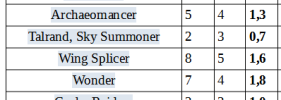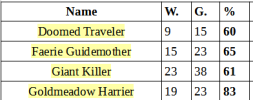Onderzeeboot
Ecstatic Orb
Hahahaha, the page break makes this the perfect troll XD
Do you, or anyone else, feel that running Talisman/Signets takes away from green's ramp identity?
I actually switched some of green's ramp from 2MV to 3MV in my current cube, because ramp can easily take up so much space space in 1-2 MV that it crowds out everything else in green. I'm trying to some aggro and madness elements to green after reading the thread below, and I think a slower ramp will still be fine. The three mana guys do more interesting stuff to support multiple archetypes, too.Yes. This is exactly why I run 3 mv mana rocks. Also, because 3 mv mana rocks kind of suck, I designed a whole bunch of custom 3 mv rocks myself.
@ravnic
Do you, or anyone else, feel that running Talisman/Signets takes away from green's ramp identity?
Could it be that you run a bunch of Talismans, so they end up both in the winning decks and the losing decks? Just wondering!The talismans aren't even that good in my environment. In the past 13 drafts, they have all together been maindecked 28 times and they only won 30 matches. That's barely a 1.07 match win rate. At the same time, my green ramp spells have been played 54 times and collected 82 wins, which is a 1.52 match win rate. I think the reason though is mostly synergy with powerful themes like landfall.
Could it be that you run a bunch of Talismans, so they end up both in the winning decks and the losing decks? Just wondering!
Could it be that you run a bunch of Talismans, so they end up both in the winning decks and the losing decks? Just wondering!
I don't really know how you calculate your numbers, but on second thought, shouldn't a "winning rate" be between 0 and 1? If two decks with a Talisman in them face each other, one wins, and one loses, you've got 2 matches played, and only 1 won, for a 0.50 winning rate. It looks like you are dividing the number of matches won by the number of maindeck inclusions, which is... well, I don't know how you would call that numberThey are definitely notfor every deck. Also, if they were average, they would be closer to 1.5, right?
It's just calculating win percentage relative to going 3-0 or 0-3 instead of every individual match, the number tells you the expected outcome of a deck with talismans is barely above 1-2. It erases the nuance of someone going 2-0 every match compared to 2-1, but, well, ultimately it doesn't matter how many games you lose as long as you win your matches, so in a sense this models reality and is more lenient on decks that might have a bit more variance.I don't really know how you calculate your numbers, but on second thought, shouldn't a "winning rate" be between 0 and 1? If two decks with a Talisman in them face each other, one wins, and one loses, you've got 2 matches played, and only 1 won, for a 0.50 winning rate. It looks like you are dividing the number of matches won by the number of maindeck inclusions, which is... well, I don't know how you would call that number
But the difference can be huge. Obviously the following calculation is going to be skewed to the max, but say the Talisman decks got a 1-2 in all of their losses, but won their matches with 2-0, and the Ramp decks instead won their matches with 2-1, but their losses were 0-2's.It's just calculating win percentage relative to going 3-0 or 0-3 instead of every individual match, the number tells you the expected outcome of a deck with talismans is barely above 1-2. It erases the nuance of someone going 2-0 every match compared to 2-1, but, well, ultimately it doesn't matter how many games you lose as long as you win your matches, so in a sense this models reality and is more lenient on decks that might have a bit more variance.


Are these stats based on the card being in the deck that won? I assume you're not tracking whether or not the card was drawn or cast, as that's far more difficult.
Help me get some quick data. How many cards are in your cube that you'll usually cast at mv>6? Meaning something like Myr Enforcer or Virtue of Persistence don't really count, as they're cast for mv<7 and mv=2, primarily.
I want some idea of how many a normal cube runs so that I can see how far to push my cube.
Forgot about that one. So one for me.I think Nexus of Fate is my only one.
